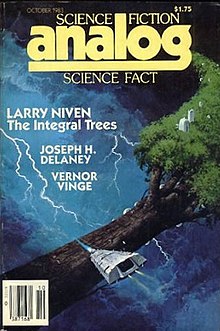The Integral Trees

Cover of first edition (hardcover)
|
|
| Author | Larry Niven |
|---|---|
| Country | United States |
| Language | English |
| Series | The State |
| Genre | Science fiction novel |
| Publisher | Del Rey Books |
|
Publication date
|
1984 |
| Media type | Print (hardback & paperback) |
| Pages | 240 pp |
| Award | Locus Award for Best Science Fiction Novel (1985) |
| ISBN | |
| OCLC | 9893599 |
| 813/.54 19 | |
| LC Class | PS3564.I9 I54 1984 |
| Preceded by | A World Out of Time |
| Followed by | The Smoke Ring |
The Integral Trees is a 1984 science fiction novel by Larry Niven (first published as a serial in Analog in 1983). Like much of Niven's work, the story is heavily influenced by the setting: a gas torus, a ring of air around a neutron star. A sequel, The Smoke Ring, was published in 1987.
It was nominated for the Nebula Award for Best Novel in 1984, and the Hugo Award for Best Novel in 1985.
The story occurs around the fictional neutron star Levoy's Star (abbreviated "Voy"). The gas giant Goldblatt's World (abbreviated "Gold") orbits this star just outside its Roche limit and therefore its gravity is insufficient to keep its atmosphere, which is pulled loose into an independent orbit around Voy and forms a ring that is known as a gas torus. The gas torus is huge—one million kilometers thick—but most of it is too thin to be habitable. The central part of the Gas Torus, where the air is thicker, is known as the Smoke Ring. The Smoke Ring supports a wide variety of life.
No "ground" exists in the Smoke Ring; it consists entirely of sky. Furthermore, the Smoke Ring is in orbit and therefore in free fall: there is no "up" or "down". Most animals have trilateral symmetry that allows them to see in all directions. The majority of Smoke Ring animals have evolved to fly on at least an occasional basis—even the fish. The Smoke Ring contains numerous "ponds," globs of water of various sizes which float free like everything else. While there are aquatic and amphibious animals in the Smoke Ring that live the majority of their lives in such ponds, these animals may find their habitat unsuitable at any moment. Whether their home pond drifts too far out of the habitable center of the Smoke Ring and into the gas torus, becomes too large and breaks up due to tidal forces, or impacts a large object such as an integral tree, aquatic animals must be able to propel themselves through the air sometimes in order to find a new place to live.
...
Wikipedia
